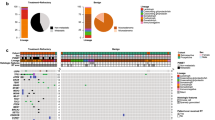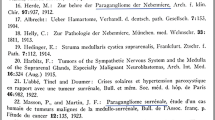Abstract
The objective of this study was to determine global gene expression in relation to Vestibular schwannomas (VS) growth rate and to identify signal transduction pathways and functional molecular networks associated with growth. Repeated magnetic resonance imaging (MRI) prior to surgery determined tumor growth rate. Following tissue sampling during surgery, mRNA was extracted from 16 sporadic VS. Double stranded cDNA was synthesized from the mRNA and used as template for in vitro transcription reaction to synthesize biotin-labeled antisense cRNA, which was hybridized to Affymetrix HG-U133A arrays and analyzed by dChip software. Differential gene expression was defined as a 1.5-fold difference between fast and slow growing tumors (><0.5 ccm/year), employing a p-value <0.01. Deregulated transcripts were matched against established gene ontology. Ingenuity Pathway Analysis was used for identification of signal transduction pathways and functional molecular networks associated with tumor growth. In total 109 genes were deregulated in relation to tumor growth rate. Genes associated with apoptosis, growth and cell proliferation were deregulated. Gene ontology included regulation of the cell cycle, cell differentiation and proliferation, among other functions. Fourteen pathways were associated with tumor growth. Five functional molecular networks were generated. This first study on global gene expression in relation to vestibular schwannoma growth rate identified several genes, signal transduction pathways and functional networks associated with tumor progression. Specific genes involved in apoptosis, cell growth and proliferation were deregulated in fast growing tumors. Fourteen pathways were associated with tumor growth. Generated functional networks underlined the importance of the PI3K family, among others.




Similar content being viewed by others
References
Trofatter JA, MacCollin MM, Rutter JL et al (1993) A novel moesin-, ezrin-, radixin-like gene is a candidate for the neurofibromatosis 2 tumor suppressor. Cell 75(4):826. http://www.ncbi.nlm.nih.gov/pubmed/8242753
Stangerup S-E, Caye-Thomasen P, Tos M, Thomsen J (2006) The natural history of vestibular schwannoma. Otol Neurotol 27:547–552. doi:10.1097/01.mao.0000217356.73463.e7
Rouleau GA, Merel P, Lutchman M et al (1993) Alteration in a new gene encoding a putative membrane-organizing protein causes neuro-fibromatosis type 2. Nature 363(6429):515–521. doi:10.1038/363515a0
Cayé-Thomasen P, Borup R, Stangerup S-E, Thomsen J, Nielsen FC (2010) Deregulated genes in sporadic vestibular schwannomas. Otol Neurotol 31(2):256–266. doi:10.1097/MAO.0b013e3181be6478
Aarhus M, Bruland O, Sætran HA, Mork SJ, Lund-Johansen M, Knappskog PM (2010) Global gene expression profiling and tissue microarray reveal novel candidate genes and down-regulation of the tumor suppressor gene CAV1 in sporadic vestibular schwannomas. Neurosurgery 67(4):998–1019. doi:10.1227/NEU.0b013e3181ec7b71. (Discussion 1019)
Torres-Martin M, Lassaletta L, San-Roman-Montero J et al (2013) Microarray analysis of gene expression in vestibular schwannomas reveals SPP1/MET signaling pathway and androgen receptor deregulation. Int J Oncol 42(3):848–862. doi:10.3892/ijo.2013.1798
Gentleman RC, Carey VJ, Bates DM et al (2004) Bioconductor: open software development for computational biology and bioinformatics. Genome Biol 5(10):R80. doi:10.1186/gb-2004-5-10-r80
Wu Z, Irizarry RA, Gentleman R, Murillo FM, Spencer F (2004) A model based background adjustement for oligonucleotide expression arrays. J Am Stat Assoc 99(468):909–917. doi:10.1198/016214504000000683
Li C, Wong WH (2001) Model-based analysis of oligonucleotide arrays: expression index computation and outlier detection. Proc Natl Acad Sci USA 98:31–36. doi:10.1073/pnas.98.1.31
Ashburner M, Ball CA, Blake JA et al (2000) Gene ontology: tool for the unification of biology. The gene ontology consortium. Nat Genet 25(1):25–29. doi:10.1038/75556
Hansen MR, Linthicum FH (2004) Expression of neuregulin and activation of erbB receptors in vestibular schwannomas: possible autocrine loop stimulation. Otol Neurotol 25:155–159. doi:10.1097/00129492-200403000-00013
Doherty JK, Ongkeko W, Crawley B, Andalibi A, Ryan AF (2008) ErbB and Nrg: potential molecular targets for vestibular schwannoma pharmacotherapy. Otol Neurotol 29(1):50–57. doi:10.1097/mao.0b013e31815d4429
Boin A, Couvelard A, Couderc C et al (2014) Proteomic screening identifies a YAP-driven signaling network linked to tumor cell proliferation in human schwannomas. Neuro Oncol 16(9):1196–1209. doi:10.1093/neuonc/nou020
Hansen MR, Roehm PC, Chatterjee P, Green SH (2006) Constitutive neuregulin-1/ErbB signaling contributes to human vestibular schwannoma proliferation. Glia 53:593–600. doi:10.1002/glia.20316
Pegram MD (2013) Treating the HER2 pathway in early and advanced breast cancer. Hematol Oncol Clin North Am 27(4):751–765. doi:10.1016/j.hoc.2013.05.007
Tao Y, Dai P, Liu Y et al (2009) Erbin regulates NRG1 signaling and myelination. Proc Natl Acad Sci USA 106(23):9477–9482. doi:10.1073/pnas.0901844106
Cayé-Thomasen P, Werther K, Nalla A et al (2005) VEGF and VEGF receptor-1 concentration in vestibular schwannoma homogenates correlates to tumor growth rate. Otol Neurotol 26(1):98–101. http://www.ncbi.nlm.nih.gov/pubmed/15699727
Cayé-Thomasen P, Baandrup L, Jacobsen GK, Thomsen J, Stangerup S-E (2003) Immunohistochemical demonstration of vascular endothelial growth factor in vestibular schwannomas correlates to tumor growth rate. Laryngoscope 113:2129–2134. doi:10.1097/00005537-200312000-00014
Plotkin SR, Stemmer-Rachamimov AO, Barker FG et al (2009) Hearing improvement after bevacizumab in patients with neurofibromatosis type 2. N Engl J Med 361:358–367. doi:10.1056/NEJMoa0902579
Foley KS, Young PW (2014) The non-muscle functions of actinins: an update. Biochem J 459:1–13. doi:10.1042/BJ20131511
Persad S, Attwell S, Gray V et al (2000) Inhibition of integrin-linked kinase (ILK) suppresses activation of protein kinase B/Akt and induces cell cycle arrest and apoptosis of PTEN-mutant prostate cancer cells. Proc Natl Acad Sci USA 97(7):3207–3212. doi:10.1073/pnas.97.7.3207
Persad S, Attwell S, Gray V et al (2001) Regulation of protein kinase B/Akt-serine 473 phosphorylation by integrin-linked kinase: critical roles for kinase activity and amino acids arginine 211 and serine 343. J Biol Chem 276(29):27462–27469. doi:10.1074/jbc.M102940200
Parsons DW, Wang T-L, Samuels Y et al (2005) Colorectal cancer: mutations in a signalling pathway. Nature 436:792. doi:10.1038/436792a
Bostner J, Ahnström Waltersson M, Fornander T, Skoog L, Nordenskjöld B, Stål O (2007) Amplification of CCND1 and PAK1 as predictors of recurrence and tamoxifen resistance in postmenopausal breast cancer. Oncogene 26:6997–7005. doi:10.1038/sj.onc.1210506
Ong CC, Jubb AM, Haverty PM et al (2011) Targeting p21-activated kinase 1 (PAK1) to induce apoptosis of tumor cells. Proc Natl Acad Sci USA 108(18):7177–7182. doi:10.1073/pnas.1103350108
Li W, You L, Cooper J et al (2010) Merlin/NF2 suppresses tumorigenesis by inhibiting the E3 ubiquitin ligase CRL4(DCAF1) in the nucleus. Cell 140(4):477–490. doi:10.1016/j.cell.2010.01.029
Kissil JL, Wilker EW, Johnson KC, Eckman MS, Yaffe MB, Jacks T. Merlin, the product of the Nf2 tumor suppressor gene, is an inhibitor of the p21-activated kinase, Pak1. Mol Cell. 2003;12(4):841–849. http://www.ncbi.nlm.nih.gov/pubmed/14580336
Xiao G-H, Beeser A, Chernoff J, Testa JR (2002) p21-activated kinase links Rac/Cdc42 signaling to merlin. J Biol Chem 277(2):883–886. doi:10.1074/jbc.C100553200
Ho CC, Liao WY, Wang CY et al (2008) TREM-1 expression in tumor-associated macrophages and clinical outcome in lung cancer. Am J Respir Crit Care Med 177(19):763–770. doi:10.1164/rccm.200704-641OC
Liao R, Sun TW, Yi Y et al (2012) Expression of TREM-1 in hepatic stellate cells and prognostic value in hepatitis B-related hepatocellular carcinoma. Cancer Sci 103:984–992. doi:10.1111/j.1349-7006.2012.02273.x
Wu J, Li J, Salcedo R, Mivechi NF, Trinchieri G, Horuzsko A (2012) The proinflammatory myeloid cell receptor TREM-1 controls Kupffer cell activation and development of hepatocellular carcinoma. Cancer Res 72(16):3977–3986. doi:10.1158/0008-5472.CAN-12-0938
Beg AA, Baltimore D (1996) An essential role for NF-kappaB in preventing TNF-alpha-induced cell death. Science 274(5288):782–784. doi:10.1126/science.274.5288.782
Joos S, Otaño-Joos MI, Ziegler S et al (1996) Primary mediastinal (thymic) B-cell lymphoma is characterized by gains of chromosomal material including 9p and amplification of the REL gene. Blood 87(4):1571–1578
Biswas DK, Shi Q, Baily S et al (2004) NF-kappa B activation in human breast cancer specimens and its role in cell proliferation and apoptosis. Proc Natl Acad Sci USA 101:10137–10142. doi:10.1073/pnas.0403621101
Hennigan RF, Moon CA, Parysek LM et al (2012) The NF2 tumor suppressor regulates microtubule-based vesicle trafficking via a novel Rac, MLK and p38SAPK pathway. Oncogene 29(9):997–1003. doi:10.1038/onc.2012.135
Yang DP, Kim J, Syed N et al (2012) p38 MAPK Activation Promotes Denervated Schwann Cell Phenotype and Functions as a Negative Regulator of Schwann Cell Differentiation and Myelination. J Neurosci 32(21):7158–7168. doi:10.1523/JNEUROSCI.5812-11.2012
Dilwali S, Briët MC, Kao S-Y et al (2015) Preclinical validation of anti-nuclear factor-kappa B therapy to inhibit human vestibular schwannoma growth. Mol Oncol 1–12. doi:10.1016/j.molonc.2015.03.009
Samuels Y, Wang Z, Bardelli A et al (2004) High frequency of mutations of the PIK3CA gene in human cancers. Science 304:554. doi:10.1126/science.1096502
Jacob A, Lee TX, Neff BA, Miller S, Welling B, Chang L-S (2008) Phosphatidylinositol 3-kinase/AKT pathway activation in human vestibular schwannoma. Otol Neurotol 29(1):58–68. doi:10.1097/mao.0b013e31816021f7
Agnihotri S, Gugel I, Remke M et al (2014) Gene-expression profiling elucidates molecular signaling networks that can be therapeutically targeted in vestibular schwannoma. J Neurosurg 121:1434–1445. doi:10.3171/2014.6.JNS131433
Funding
No funding was received in regards to this study.
Author information
Authors and Affiliations
Corresponding author
Ethics declarations
Conflict of interest
The authors hold no conflicting interest.
Electronic supplementary material
Below is the link to the electronic supplementary material.
Rights and permissions
About this article
Cite this article
Sass, H.C.R., Borup, R., Alanin, M. et al. Gene expression, signal transduction pathways and functional networks associated with growth of sporadic vestibular schwannomas. J Neurooncol 131, 283–292 (2017). https://doi.org/10.1007/s11060-016-2292-9
Received:
Accepted:
Published:
Issue Date:
DOI: https://doi.org/10.1007/s11060-016-2292-9




